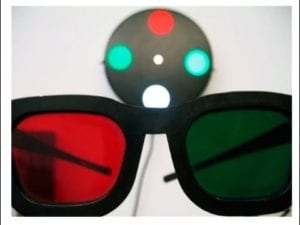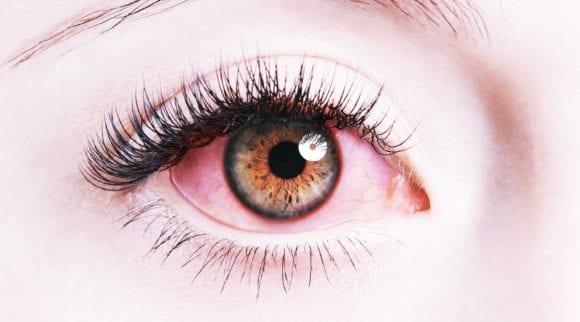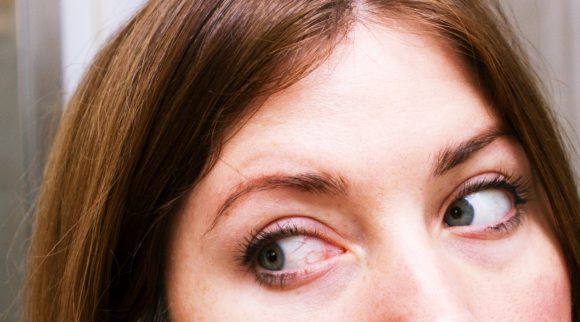Dominant Eye Test: How to Find Your Dominant Eye - Eye Love Cares

Early in life, you begin to favor a dominant hand and foot. You either write with your left or your right. You kick or have more strength in one foot than the other. The same is true for your eyes. Even if your vision is the same in both eyes, you will most likely have a dominant eye. Trying a dominant eye test can help you determine your dominant eye. In most people their dominant eye will be the better in vision of the two, but it can also work the other way around. It has also been confirmed in studies that people who are right handed do not necessarily have right eye dominance.
Knowing which eye is dominant is important in completing some everyday tasks. Your dominant eye can transmit signals to the brain faster and more efficiently. You may first begin to use eye dominance when using a microscope in school or notice your level of performance in sports like baseball and golf. Most athletes know if they are right-handed or left-handed and can mold their physicality around these advantages or in some cases limitations. Using this information along with accurate eye dominance information can greatly increase their athletic ability. Understanding eye dominance can help increase hand eye coordination and can help you choose a sport that fits your body makeup. Those with cross-dominance, for example, will have a harder time with sports that require a precise target like archery.
If you are interested in finding out which eye is dominant, there are sighting and sensory tests that are quick and painless. While some tests are thought to be more accurate than others, all tests can give you better insight on your dominant eye.
Related: Why Is My Eye Twitching?

Dominant Eye Explained
 Everyone has a dominant eye. You can have a dominant eye that has slightly better vision or a dominant eye that is the same as the normal functioning of the pair. In either case, the dominant eye will have better vision in that it will be able to relay brain signals better in regards to the landscape of objects.
Everyone has a dominant eye. You can have a dominant eye that has slightly better vision or a dominant eye that is the same as the normal functioning of the pair. In either case, the dominant eye will have better vision in that it will be able to relay brain signals better in regards to the landscape of objects.
Dominant Eye Test
While some people will be able to discern their dominant eye without a test, there are several eye tests that can help you confirm your dominant eye. The first set of tests are called sighting dominance tests.
Sighting Dominance Eye Tests
Two of the most common sighting dominance eye tests are the Miles test and the Porta test. Both are very straightforward, do not require any special tools and only take a few seconds to complete.
Miles Test
 In order to find your dominant eye, you will first place your arms out in front of you creating a triangular opening between your thumbs and forefingers. You can do this by touching the tips of your forefingers together which will slightly overlap your thumbs (which become the bottom of the triangle).
In order to find your dominant eye, you will first place your arms out in front of you creating a triangular opening between your thumbs and forefingers. You can do this by touching the tips of your forefingers together which will slightly overlap your thumbs (which become the bottom of the triangle).
Once you have formed the triangle, focus on a distant object with both eyes open. It is best to focus on a singular object with blank wall space around it. This will help you zero in on the object.
Center the triangle you have formed with your hands around the object. Close your left eye. If the object stays centered, the eye that is open (the right eye) is your dominant eye. If the object moves out of frame, then your left eye (or the eye that is closed) is your dominant eye.
Alternatively, you can complete the Miles test by completing the steps above and then taking your hands (while the triangle is still formed) and slowly draw them in closer to your face while still focusing on the distant object. Once your hands touch your face they will be placed clearly over your left or your right eye. The eye that they are framing is your dominant eye.
Related: How Much Do Contacts Cost?
Porta Test
 The Porta test works in a similar fashion by placing your thumb or forefinger in the line of sight of a distant object. The same rules apply; it’s best to focus on a singular object surrounded by blank wall space with both eyes open.
The Porta test works in a similar fashion by placing your thumb or forefinger in the line of sight of a distant object. The same rules apply; it’s best to focus on a singular object surrounded by blank wall space with both eyes open.
Center your thumb or forefinger over the object and focus with both eyes. You may see your finger look like it partially disappears — this is normal. Then close your left eye. If your finger remains in the center of the object, your open eye or right eye is your dominant eye. If the object is off-center from your finger then your closed eye, or right eye, is your dominant eye.
Both of these tests are considered under the “sighting” category, similar to looking through the sight on a gun.
For the most part, these simple sighting tests that you can do in the comfort of your own home are accurate. However, there is some discrepancy for non-visual factors and handedness.
If you think this may be affecting your dominant eye test results, you can also perform non-sighting dominant eye tests. Non-sighting tests require the use of special optical devices while both eyes remain open. However, these tests can be difficult to complete due to lack of specialized vision clinics and nearby research labs.
Sensory Eye Dominance Tests
 Sensory eye dominance testing measures the sensory balance between the eyes. Instead of measuring by sight distance, the measure of perceptual contribution of each eye is tabulated. Sensory eye tests measure binocular vision or the vision formed when using both eyes. There are several sensory eye dominance tests. Most require an eye doctor to read the results and professional ocular tools to test the participant.
Sensory eye dominance testing measures the sensory balance between the eyes. Instead of measuring by sight distance, the measure of perceptual contribution of each eye is tabulated. Sensory eye tests measure binocular vision or the vision formed when using both eyes. There are several sensory eye dominance tests. Most require an eye doctor to read the results and professional ocular tools to test the participant.
A few of the more popular tests include the Worth’s four dot test, Freiburg ocular prevalence test, Haase stereo-balance test and the monocular blur test.
Worth’s Four Dot Test
 Worth’s four dot test (Worth Four Light Test, W4LT) gives an estimated measurement of sensory eye dominance (SED). This test quantifies the participant’s binocular vision and binocular single vision. Suppression of either eye can cause vision problems. Although performed in early childhood, it can be difficult for children to complete and communicate their results.
Worth’s four dot test (Worth Four Light Test, W4LT) gives an estimated measurement of sensory eye dominance (SED). This test quantifies the participant’s binocular vision and binocular single vision. Suppression of either eye can cause vision problems. Although performed in early childhood, it can be difficult for children to complete and communicate their results.
In the Worth’s four dot test, the participant wears red and green anaglyph glasses (green on the left and red on the right) and states the number and color of four illuminated circles (1 red, 2 green, 1 white). This test can be performed close to the participant (measured in cm) and at a distance (6m). The lights are arranged in a diamond pattern with red on top, two green lights in the middle and a white light on the bottom.
By coloring the lights in both red and green and giving the participant red and green glasses to wear, this test can determine if the participant is suppressing one of their eyes. If they have good vision, they will see all four lights. If there is eye suppression, they will see two or three lights. If the participant is unable to naturally fuse the diamond image with binocular vision, they will see five lights.
Freiburg Ocular Prevalence Test
The Freiburg Ocular Prevalence Test uses stereopsis to detect whether or not a vertical line surrounded by a frame with a random pattern of black and white squares is in front of behind other features. Stereopsis is when the brain measures depth perception from a combination of both eyes using binocular vision.
The graphic for the Freiburg test is placed 4.5 meters from the participant on a visual display unit (VDU). The visual display unit is 36 cm wide by 27 cm high and has a resolution of 800×600 pixels (120 Hz frame rate).
The participant wears a pair of ferroelectric liquid crystal shutter goggles to completely separate the vision of the left and right eye. The test has also been completed by separating the eyes with mirrors. The participant then decides whether the line is in front of or behind. Once a decision is made, they choose the proper response using a USB keypad connected to a computer. These responses are then measured and a conclusion is made.
The Freiburg Stereoacuity Test advantage is that it can detect very small stereo disparities. In the case of stereovision, the test can show how the eye sees objects from different angles and then combines these angles to produce a 3D image. The disadvantage of it is that the position of the target can skew results, even with the target being randomly placed to the right or left.
Stereopsis tests are beneficial in identifying major eye diseases including blindness. Ophthalmology practices will have various stereopsis tests on hand if there is concern of eye  disease or for learning more about the participant’s eye makeup.
disease or for learning more about the participant’s eye makeup.
Haase Stereo-balance Test
Haase’s stereo-balance test is comprised of a series of triangles. These triangles are randomly shown with crossed or uncrossed stereo disparity. The participant’s role is to speak up when they see an offset in the set of triangles.
If the participant sees no lateral offset of the triangles when presented with crossed stereo disparity, then both eyes are contributing equally to binocular vision. If the participant sees an offset of triangles to the right in the case of uncrossed stereo disparity, this can lead to a determination of right eye dominance and an inferiority of the left eye.

Monocular Blur Test
The monocular blur test is performed by an eye doctor and is usually the preferred method for figuring out eye dominance before prescribing monovision or multifocal contact lenses. The eye doctor will use a +1.50 lens and ask the participant whether they prefer the right eye or the left eye being blurred.
This test is often part of a standard eye exam but it can also be used to determine eye dominance.
Which Tests are Better, Sighting or Sensory?
 While both tests claim to find your dominate eye, critics disagree on how accurate these tests really are. In sighting tests, right eye dominance is about twice as common as left eye dominance. In sensory tests, left and right eye dominance measures about the same.
While both tests claim to find your dominate eye, critics disagree on how accurate these tests really are. In sighting tests, right eye dominance is about twice as common as left eye dominance. In sensory tests, left and right eye dominance measures about the same.
Sighting tests are quick and easy and can be completed by yourself using your own hands as the optical tools. Sensory tests are best completed by an eye professional. Sensory tests commonly use both eyes to find your dominant one while sighting tests have you close one eye and use your open eye’s focus to determine dominance.
As in all tests the participant (as well as the eye doctor in certain testing) can influence the outcome by how the test is performed. You may have right-eye dominance when performing sighting tests but prefer your left eye when completing a sensory test. Even your hands and the angle that you gaze past through the triangle or through your finger to complete the test can skew the results.
Since both eyes are needed to properly function visually and factoring in the use of peripheral vision, our ocular dominance can change depending on the activity. Most individuals can change their eye dominance to fit the situation or report not having a clear eye dominance.
Sighting dominance eye tests and sensory eye tests do not take into account the advantage of enhanced sight using both eyes. People using both eyes for their daily vision tend to balance their vision between both eyes. This helps reduce eye strain and creates a more balanced vision frame. This result explains why the ocular testing is controversial and why so many people have a hard time determining their dominant eye.
Related: Monovision With Contact Lenses
The Correlation Between Eye Dominance and Handedness
While most right-handed people are also right eye dominant, this is not always the case. Population studies show that about 90 percent of people are right-handed and about 67 percent are right-eye dominant.
It is important to note that handedness tests alone cannot confirm if you are right or left-eye dominant. Using your dominant hand to perform a dominant eye test can skew the results. Just as you tend to hold a pencil or swing a bat with one hand more than the other, the strength of this hand can cause you to look more in that direction or rely more on that side of your body.
Current research is finding that we may have more of a mixed ocular dominance or a dominance in either eye for different situations. While we may lean on one eye most of the time, based on our handedness, we may be subconsciously thinking our dominant eye is on the same side.
No Dominant Eye
 While it is possible that you do not have a dominant eye, it is more likely that you have mixed ocular dominance, or the ability to use both the left and right eyes as the dominant eye for different tasks.
While it is possible that you do not have a dominant eye, it is more likely that you have mixed ocular dominance, or the ability to use both the left and right eyes as the dominant eye for different tasks.
If you perform the above vision tests with the triangle and a single finger and find that the object does not stay in the center for either eye, you may have mixed ocular dominance.
The range of eye dominance varies greatly. Some people will have a clear eye dominance, while others may notice the object shift slightly in both eyes. Eye dominance is determined by the visual cortex (or the part of the brain that processes our vision).
The visual cortex has bands of nerve cells that form dominant eye columns. These bands that are a hardwired part of our brain will respond to one eye more than the other. While this creates dominant vision in one eye it also helps to develop our binocular vision.
As with any body system, there are varying degrees of body composition that happen with each individual person. While some may have clear bands that are preferential to one eye and make the dominant eye easy to spot, some people will have overlapping or missing bands that may make determining the dominant eye more difficult.

Prevention of Eye Diseases
Starting in childhood, observing eye dominance can be beneficial for many reasons. A variety of treatable eye diseases can be corrected by taking action early on before the disease has a chance to progress.
Amblyopia
If there is any imbalance in the eyes early in life, it can lead to a loss of visual sharpness in the non-dominant eye. This condition is referred to as amblyopia. Most people will recognize this disease by how it is treated. Children are required to wear an eye patch to improve the sharpness in vision of the weaker eye.
Macular Disease
Later in life, those who suffer from age-related macular-disease can benefit from eye dominance testing. Macular disease can cause changes to binocular balance and therefore testing is used as a baseline for the progression of the disease and as a reference for other related eye diseases.
Benefits of Knowing Your Dominant Eye
 Being able to use your dominant eye efficiently in your everyday life and hobbies can make them more enjoyable. You may even improve your photography skills, beat your friends at the shooting range or pick up a new sport like baseball or golf.
Being able to use your dominant eye efficiently in your everyday life and hobbies can make them more enjoyable. You may even improve your photography skills, beat your friends at the shooting range or pick up a new sport like baseball or golf.
Photography
Dominant eye is also important in photography. When looking into the view finder to frame your shot, using your dominant eye will let you know exactly what it is in the frame. However, if you use your non-dominant eye, can frame the shot incorrectly or place your composition outside of the framing area.
Increased Athletic Performance
If you have ever gone to the shooting range and had a hard time hitting a target, it might be because you have crossed dominance. If you are right-handed but are left-eye dominant, this makes it harder for you to focus and position your body correctly. You may be placing the gun on your right shoulder (as right-handers do) but if you are left-eye dominant, that means you would have to cross the gun across your upper body to aim.
If this is a problem you are struggling with, you will need to make adjustments to your shooting in order to improve your shot. One of the ways you can improve your shooting game is to keep both of your eyes open until just before you shoot the gun. Keeping both eyes open will utilize your peripheral vision and depth perception. Right before you take the shot, close your dominant eye to make the final adjustment.
Sports also play a key role in using your dominant eye. In activities like baseball and golf, the eyes have to rotate to follow and connect with the ball. If you are not following your dominant eye or have a mixed or crossed dominance, you will have a hard time making contact with the ball.
It can be frustrating to deal with mixed or crossed dominance, especially if you think it is a vision problem and not just a lack of knowledge about eye dominance. If you are experiencing eye focus issues while playing sports, consider seeking out a specialized eye doctor that has a concentration in sports vision.
Ocular dominance is the study of the eyes in which one eye can see images more clearly, stabilized and even larger than the other eye. Your dominant eye might even be receiving and processing related brain signals faster than your non-dominant eye.

Conclusion
Although current research has shown that each person has a single, dominant eye, there has not been enough study to prove this concept. In fact, several tests have concluded that some people can switch which eye is dominant depending on the situation and even share their vision between eyes so closely that one eye is not clearly dominant over the other.
To determine dominant eye, a dominant eye test can be performed including those based in sighting and another type using sensory-based testing.
Sighting tests are as simple as looking through a pin-hole in a card or using your hands to form a triangle and focusing on an object. However, while easily performed by the participant with no outside ocular tools, the angle of the gaze and the participant’s hand dominance can skew the results.
In sensory testing, more detailed tests are completed using both eyes to measure binocular vision and binocular rivalry. Sensory testing is thought to be more thorough than sighting testing but the results can still be skewed by the participant and the eye doctor performing the testing.
Recognizing eye dominance is important when correcting vision that is not 20/20 in both near and far sightedness. When testing monovision, the dominant eye is corrected for distance, while the non-dominant eye is corrected for reading up close. Basically, treating the dominant eye for seeing far away can give you better vision as the dominant eye in normal circumstances has clearer vision and faster signals to the brain. This will suppress the non-dominant eye and allow this eye to concentrate on objects close to the eye since it is not as strong and does not send and receive brain signals as quickly.
If you are interested in figuring out your dominant eye, there are several tests you can complete at home. There are even video tutorials that show you how to do a sighting test if you find the written instructions difficult to follow. Keep in mind that sighting tests done at home can be skewed by using your dominant hand and the angle that you perform the test. Sensory testing can also be completed by understanding how your eyes interact together.
Chances are you are looking into dominate eye testing due to being frustrated with your sight or wanting to improve your sports game. In either case, it would be beneficial to talk to your eye doctor if you are interested in getting a professional opinion on which of your eyes is dominant. While even professional testing might not be a hundred percent accurate, since a dominant eye test is still being quantified for accuracy, getting tested might help you understand complex vision issues.
Especially if you are experiencing vision issues or think you may cross dominance (in which your dominant hand is on a different side than your dominant eye), it is best to speak to your eye doctor with your concerns. A dominant eye test can also help find any eye diseases or blindness that may affect you long term. While determining your dominant eye may be much harder than knowing your dominant hand or foot, understanding which eye is dominant can improve your balance, help you take charge of your vision and maybe even improve your target practice too.
FAQs about Dominant Eye Test













